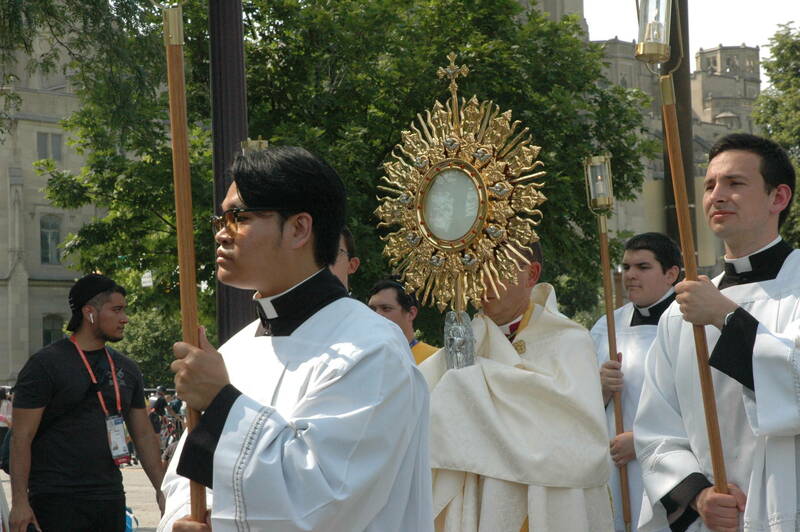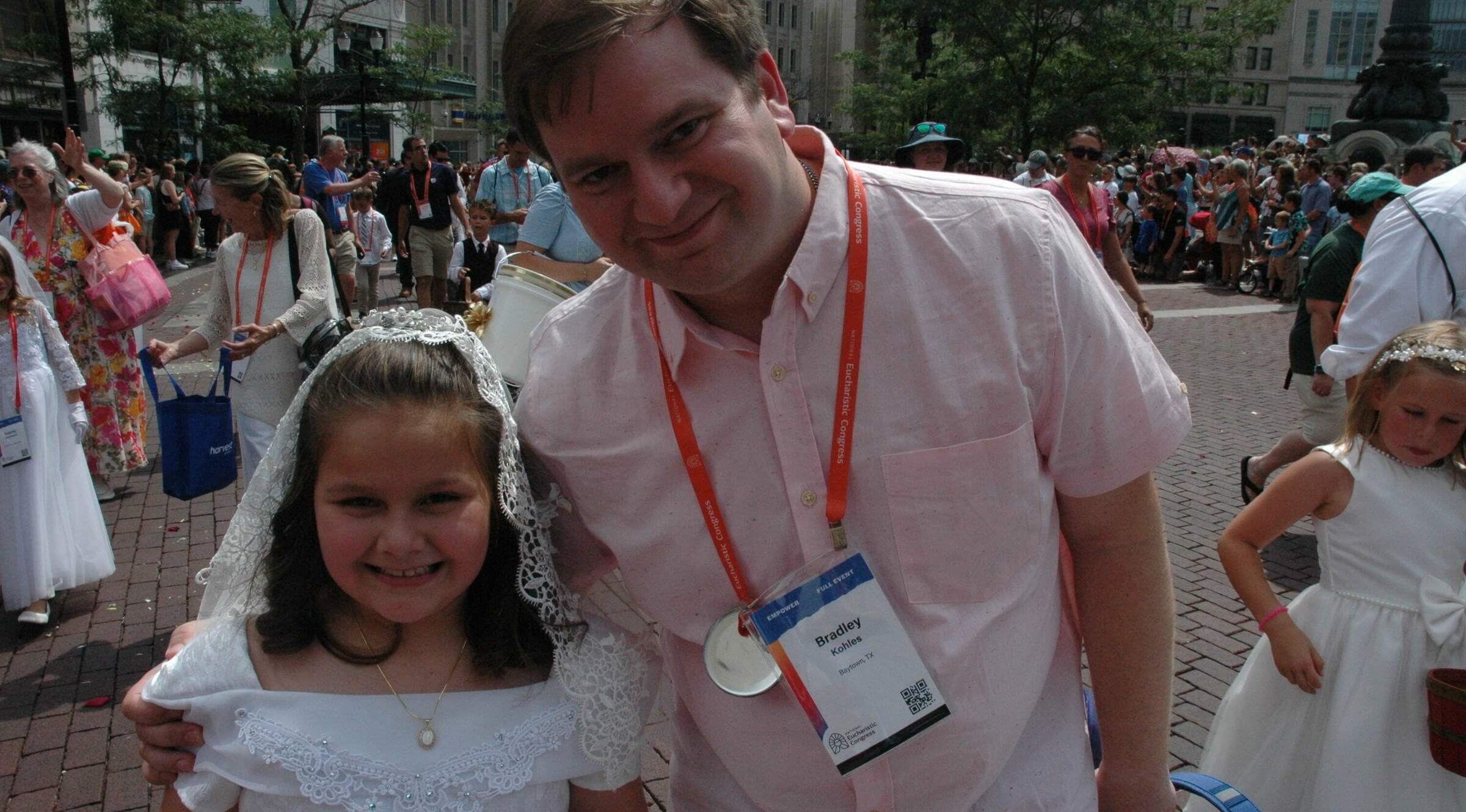 A monstrance containing the Eucharist is carried in a July 20 procession in Indianapolis that drew more than 50,000 Catholics during the National Eucharistic Congress. Photography by John Shaughnessy ’77
A monstrance containing the Eucharist is carried in a July 20 procession in Indianapolis that drew more than 50,000 Catholics during the National Eucharistic Congress. Photography by John Shaughnessy ’77
For anyone whose life has been blessed by a great love, at least two questions must be considered:
How do I show the depth of my love and appreciation for this wondrous gift?
And how do I let the world know how much this person means to me?
On the sun-kissed afternoon of July 20, more than 50,000 Catholics from across the country answered these questions of the heart by sharing their reverence, awe and love for Jesus Christ and his life-changing and world-changing gift of the Eucharist during an emotionally charged procession through the streets of downtown Indianapolis.
The procession marked the culmination of the 10th National Eucharistic Congress, the first in the United States since before America entered World War II. Beginning in May, a quarter of a million people participated in a 60-day pilgrimage along four routes around the country that covered a total of 6,500 miles. That included a July 5 procession through South Bend to the Basilica of the Sacred Heart at Notre Dame before continuing toward Indianapolis.
There, the five-day National Eucharistic Congress brought together priests, religious sisters, bishops, seminarians, older people, young adults, teens, children, Asians, Blacks, Hispanics and whites as one family of faith — smiling, crying, rejoicing, praying, singing and falling to their knees while embracing the one who sacrificed his life to redeem the world.
Walking one mile from the Indiana Convention Center to the Indiana War Memorial, tens of thousands of people jammed the streets, leading and following the float that carried the Blessed Sacrament in a gleaming, gold monstrance, while thousands of others packed the downtown Indianapolis sidewalks.
In the midst of that mass of people celebrating the Eucharist, I recalled a story from Mother Olga of the Sacred Heart. On July 18 with 50,000 people gathered in Lucas Oil Stadium in Indianapolis, the founder of the Daughters of Mary of Nazareth described meeting a mother of two who was in the last stages of cancer.
The woman had always dreamed of watching her daughter, who was then 6, walk down the aisle on her wedding day — and she knew she wouldn’t live to see that. Mother Olga set into motion a plan to give the woman a different version of her dream.
She approached the Archdiocese of Boston for permission to allow the woman’s 6-year-old daughter to receive her first Communion early. When the archdiocese approved the plan, Mother Olga asked the mother for her wedding veil, part of which Mother Olga turned into a veil that fit the girl. Then she asked hospital officials for a leave for the mother so she could attend Mass on Easter morning.
On that morning, the mother walked her daughter down the aisle toward her first Communion.
Several days later, the mother died.
Mother Olga told the audience, “In your own journey, in the journeys of your loved ones, whatever emptiness you have, go to the foot of the cross, go to Jesus, for he alone can fill every emptiness, every void in our lives.”

On the afternoon of the eucharistic procession, Indianapolis Archbishop Charles C. Thompson embraced that same belief as he rode on a float that carried the Blessed Sacrament in a large monstrance.
While his eyes concentrated on the Eucharist, he said, the people in the procession and along its route were in his thoughts.
“How many were carrying great wounds? How many had left great struggles at home? How many were struggling with employment? How many were struggling with illness, with disease? How many were struggling with addiction? How many of these people were having marital problems? How many of these people had a child who may be dying?” he said. “All of those people were here with a spirit of great gratitude. But there’s a woundedness, there’s brokenness among us. So, I was lifting them up in prayer.”
As I walked along the downtown streets before and during the procession, I talked with numerous people about why they had come and what the experience meant to them. Among them was 8-year-old Clarise Kohles, who walked with a group of girls and boys who received their first Communion this year. Wearing her white Communion dress and veil, the little girl from Texas tossed white and red rose petals on the downtown streets, paving the way for the Blessed Sacrament as she walked with her dad, Bradley.
“We went to Italy last year, and she fell in love with St. Clare and Italy in general,” Bradley Kohles said, “and she’s been on fire ever since.”
Passing by the crowds of people taking video and photos of the first Communicants, Clarise said, “I like how there are so many people here just for God.”
At the southwest corner of Meridian and Washington streets — the epicenter of Indianapolis — Holly and Richard Maes of Green Bay, Wisconsin, waited in their wheelchair and electric scooter, respectively, determined to join in the procession once the float with the Eucharist passed. Married 44 years, Richard has struggled with multiple sclerosis for about 30 years while Holly had to have her left leg amputated, the result of being hit by a drunk driver when she was 19.
“With both of us having health problems, to spend days with the Lord with so many people is invigorating,” Holly said. “I was a convert to the faith. I always felt something was missing in my youth, and I found it in the Catholic Church in the real presence of Jesus Christ in the Eucharist. And Christ is here in our midst today.”
“There’s a reason why we get the Eucharist every day,” Richard added. “It gives me spiritual nourishment. And just being around so many Catholics has recharged me. I’m ready to go back home and share everything we’ve heard here.”
John Shaughnessy’s four books include The Irish Way of Life: Stories of Family, Faith and Friendship. He is assistant editor of The Criterion, the newspaper of the Archdiocese of Indianapolis.